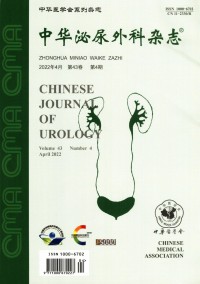The predictive value of CTCs characterization for time to castration resistance of high-volume metastatic castration sensitive prostate cancer
Q4 Medicine
引用次数: 0
Abstract
Objective To explore the predictive value of circulating tumor cells (CTCs) characterization for time to castration resistance of newly diagnosed high volume metastatic castration sensitive prostate cancer (mCSPC) patients. Methods Newly diagnosed high volume mCSPC patients were prospectively enrolled in this study from September 2015 to February 2017. The inclusion criteria include that the patients' age should be between 18 to 85 years old. The Prostate cancer should be diagnosed by biopsy or cytopathology. No endocrinological therapy, radiative therapy or chemotherapy was used before the study. High-volume metastatic lesion was confirmed by imaging. Those patients who accepted previous endocrinological therapy, radiative therapy or chemotherapy were excluded in this study. Those patients combined with concomitant tumor were also excluded. The health males were enrolled in the control group. All patients received androgen deprivation therapy (ADT) with goserelin plus bicalutamide (goserelin 3.6 mg subcutaneous injection, once a month plus bicalutamide 50mg orally, once a day). CanPatrol system was used to count CTCs in peripheral blood of patients and characterize CTCs based on expressions of epithelial markers(EpCAM and CK8/18/19) and mesenchymal markers(vimentin and twist). Primary endpoint was time to castration resistance. Survival analysis was conducted using Kaplan-Meier method and log-rank test was used to assess the difference of survival between groups, and univariate and multivariate analyses of prognostic factors were conducted using the Cox proportional hazards model. Results A total of 108 newly diagnosed high volume mCSPC patients were enrolled in this study. The median age of enrolled patients was 68 years old (ranging 51-85 years old), and median PSA was 196.2 ng/ml(ranging 5.8-5 011.9 ng/ml). The median level of hemoglobin was 32 g/L(ranging 9-172 g/L). The median level of LDH was 179 U/L(ranging 49-630 U/L). The ECOG scores was 0-1 score in 94 cases(87.0%), 2 scores in 14 cases (13.0%). The Gleason scores was 6-7 in 20 cases (18.5%) and more than 8 in 88 cases (81.5%). All patients had bone metastatic lesions, among which 41 (38.0%) patients had more than 10 metastatic lesions and 6 (5.6%) patients with visceral metastasis, 30(27.8%) patients with limb bone metastasis. The median CTCs count was four, and ranging 0-35. Mesenchymal CTCs positive and negative (negative included CTCs negative, epithelial CTCs positive and biophenotypic CTCs positive) patients were 58(53.7%) and 50, respectively. There was no correlation between CTCs characterization with age, baseline PSA, Gleason score, ALP and other clinical parameters (P>0.05). In control group, the mean age was 26 years old (ranging 20-31 years old). No CTCs were detected among those people. After a median follow-up of 24 months (ranging 18-32 months), 90 patients (83.3%) progressed to castration resistant prostate cancer (CRPC). The median time to CRPC for patients of mesenchymal CTCs positive and negative was (10.5±1.4) and (14.0±3.4) months, respectively(P<0.001). Univariate analysis revealed CTCs characterization(HR=1.647, P=0.003), the number of metastatic lesions (HR=1.624, P=0.025)and limb bone metastasis(HR=1.706, P=0.019) were prognostic factors of time to CRPC; further multivariate analysis showed that only baseline mesenchymal CTCs positive (HR=1.562, P=0.008) was independent prognostic factors of unfavorable time to CRPC. Conclusions CTCs characterization can predict time to CRPC of newly diagnosed high volume mCSPC patients receiving ADT, and patients of baseline mesenchymal CTCs positive are more likely to progress to CRPC. Key words: Prostatic neoplasms; Castration sensitive prostate cancer; Androgen deprivation therapy; Circulating tumor cells; Epithelial mesenchymal transition; Castration resistant prostate cancerctc表征对高容量转移性去势敏感前列腺癌去势抵抗时间的预测价值
目的探讨循环肿瘤细胞(CTCs)特征对新诊断的高体积转移性去势敏感前列腺癌(mCSPC)患者去势抵抗时间的预测价值。方法前瞻性纳入2015年9月至2017年2月新诊断的高容量mCSPC患者。纳入标准包括患者年龄在18 - 85岁之间。前列腺癌应通过活检或细胞病理学诊断。研究前未使用内分泌治疗、放射治疗或化疗。影像学证实有大体积转移灶。既往接受内分泌治疗、放疗或化疗的患者排除在本研究之外。合并肿瘤的患者也被排除在外。健康男性被纳入对照组。所有患者均接受戈舍雷林联合比卡鲁胺雄激素剥夺治疗(ADT)(戈舍雷林3.6 mg皮下注射,每月1次,比卡鲁胺50mg口服,每天1次)。使用CanPatrol系统对患者外周血中CTCs进行计数,并根据上皮标志物(EpCAM和CK8/18/19)和间充质标志物(vimentin和twist)的表达来表征CTCs。主要终点为去势抵抗时间。采用Kaplan-Meier法进行生存分析,采用log-rank检验评估组间生存差异,采用Cox比例风险模型对预后因素进行单因素和多因素分析。结果本研究共纳入108例新诊断的高容量mCSPC患者。入组患者的中位年龄为68岁(51-85岁),中位PSA为196.2 ng/ml(5.8-5 011.9 ng/ml)。血红蛋白中位值为32 g/L(范围9 ~ 172 g/L)。LDH的中位水平为179 U/L(范围为49-630 U/L)。ECOG评分0-1分94例(87.0%),2分14例(13.0%)。Gleason评分6-7分的20例(18.5%),大于8分的88例(81.5%)。所有患者均有骨转移灶,其中10个以上转移灶41例(38.0%),内脏转移6例(5.6%),肢体骨转移30例(27.8%)。ctc计数中位数为4,范围为0-35。间充质ctc阳性和阴性(阴性包括ctc阴性、上皮性ctc阳性和生物表型ctc阳性)分别为58例(53.7%)和50例(53.7%)。ctc特征与年龄、基线PSA、Gleason评分、ALP等临床参数无相关性(P < 0.05)。对照组患者平均年龄26岁(20 ~ 31岁)。在这些人中没有检测到ctc。中位随访24个月(18-32个月)后,90例(83.3%)进展为去势抵抗性前列腺癌(CRPC)。间充质ctc阳性和阴性患者到CRPC的中位时间分别为(10.5±1.4)个月和(14.0±3.4)个月(P<0.001)。单因素分析显示,CTCs特征(HR=1.647, P=0.003)、转移灶数量(HR=1.624, P=0.025)和肢体骨转移(HR=1.706, P=0.019)是影响CRPC时间的预后因素;进一步的多因素分析显示,只有基线间充质ctc阳性(HR=1.562, P=0.008)是CRPC不利时间的独立预后因素。结论ctc特征可以预测新诊断的接受ADT的高容量mCSPC患者到CRPC的时间,基线间充质ctc阳性的患者更有可能进展为CRPC。关键词:前列腺肿瘤;去势敏感性前列腺癌;雄激素剥夺疗法;循环肿瘤细胞;上皮间充质转化;去势抵抗性前列腺癌
本文章由计算机程序翻译,如有差异,请以英文原文为准。
求助全文
约1分钟内获得全文
求助全文
来源期刊

中华泌尿外科杂志
Medicine-Nephrology
CiteScore
0.10
自引率
0.00%
发文量
14180
期刊介绍:
Chinese Journal of Urology (monthly) was founded in 1980. It is a publicly issued academic journal supervised by the China Association for Science and Technology and sponsored by the Chinese Medical Association. It mainly publishes original research papers, reviews and comments in this field. This journal mainly reports on the latest scientific research results and clinical diagnosis and treatment experience in the professional field of urology at home and abroad, as well as basic theoretical research results closely related to clinical practice.
The journal has columns such as treatises, abstracts of treatises, experimental studies, case reports, experience exchanges, reviews, reviews, lectures, etc.
Chinese Journal of Urology has been included in well-known databases such as Peking University Journal (Chinese Journal of Humanities and Social Sciences), CSCD Chinese Science Citation Database Source Journal (including extended version), and also included in American Chemical Abstracts (CA). The journal has been rated as a quality journal by the Association for Science and Technology and as an excellent journal by the Chinese Medical Association.
 求助内容:
求助内容: 应助结果提醒方式:
应助结果提醒方式:


